There’s a Mole in our Midst
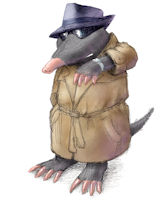 In espionage circles, a mole is a spy or deep cover/ sleeper agent who joins a target organization with the long-term goal of gaining access to its secrets. Eventually, with luck, determination and skill, they ‘dig out’ the information required to bring the organization’s activities to light (for their own nefarious purposes, or to expose them), and/or its members to justice.
In espionage circles, a mole is a spy or deep cover/ sleeper agent who joins a target organization with the long-term goal of gaining access to its secrets. Eventually, with luck, determination and skill, they ‘dig out’ the information required to bring the organization’s activities to light (for their own nefarious purposes, or to expose them), and/or its members to justice.
The term was apparently introduced to the public by writer John Carré in his 1974 novel, Tinker, Tailor, Soldier, Spy, and has since entered the modern lexicon, primarily as a result of the popularity of using ‘moles’ in spy novels, movies and television shows. While its actual origin is unclear, Le Carré (a former British Intelligence Officer), has claimed the term ‘mole’ was used by the Soviet Intelligence Agency (the KGB) before he coined it in his book. I can only assume the name of a blind, tunneling rodent with a penchant for ‘digging up dirt’ was chosen as a euphemism for an ‘underground spy’ because “moles often tunnel deeper than spy hunters can dig” (a headline from the New York Times; February 26, 2001).
Having never met an actual intelligence ‘mole’, I cannot attest to their ability to ‘dig deep’ or ‘tunnel through’ layers of security to find the information they are looking for. I imagine their ability to remain hidden from view, to keep what they are doing from ‘prying eyes’, and a tenacity that drives them to never give up assists them in their work. If we assume all that to be true, I can most certainly understand why whoever-it-was that first coined the term chose that particular rodent (the mole) as the archetype.
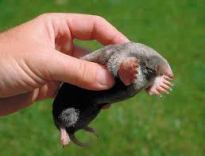
The Eastern Mole
The most common species of mole in North America is the Eastern Mole (scalopus aquaticus). They are classified as insectivores; while they do eat insects, they are far more interested in chowing down on larvae (grubs) and earthworms. These tiny (approximately 6 to 7” long) animals are dark grey, with a naked, pointed noise, nearly invisible eyes and ears, a short hairless tail, and spade-like front feet they use for digging underground (both to establish living space and to find food). The Eastern Mole consumes up to 80% of its own body weight PER DAY!

Baby Moles
Moles live a solitary life, only tolerating other moles during mating season (in the spring). After a 4 to 6 week gestation period, a litter of 3 to 5 hairless pups is born. By mid-summer, they’re able to take care of themselves and go off to establish their own territories. Moles have a lifespan of approximately 3 to 5 years; females can reproduce at 1 year of age. Because they spent 99% of their time underground (and smell pretty rank, apparently), they have few natural predators; snakes, owls, and foxes are their biggest threats (not to mention humans – but I’ll get to that in a minute).
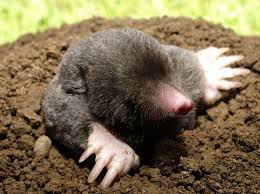 Moles can be active at any time during the day (it’s always dark below ground), but they do most of their damage tunneling between 4 and 7 a.m. They can dig at a rate of a meter (3 feet) an hour, for a total of around 18 meters (20 yards) a day. A single tunnel can be up to a kilometer (1.5 miles) in length. They can move backwards nearly as quickly as forwards, and are remarkably good swimmers. While moles have no real vision, they may be able to detect the presence of light (on those rare occasions when they emerge briefly from their tunnels). Their ears are covered by a layer of skin, but they likely detect sounds and vibrations; it is assumed they find their way around and detect prey using an acute sense of smell and touch. Because they tunnel primarily below the frost line, they do not hibernate in winter.
Moles can be active at any time during the day (it’s always dark below ground), but they do most of their damage tunneling between 4 and 7 a.m. They can dig at a rate of a meter (3 feet) an hour, for a total of around 18 meters (20 yards) a day. A single tunnel can be up to a kilometer (1.5 miles) in length. They can move backwards nearly as quickly as forwards, and are remarkably good swimmers. While moles have no real vision, they may be able to detect the presence of light (on those rare occasions when they emerge briefly from their tunnels). Their ears are covered by a layer of skin, but they likely detect sounds and vibrations; it is assumed they find their way around and detect prey using an acute sense of smell and touch. Because they tunnel primarily below the frost line, they do not hibernate in winter.
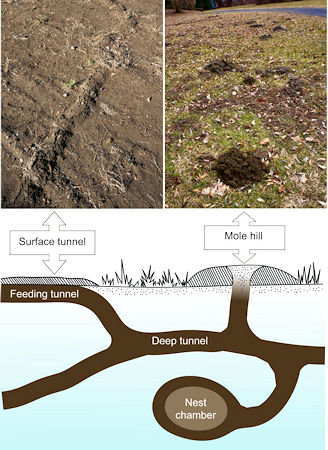
Photo from The Journal of Experimental Biology: The Company of Biologists (jeb.biologists.org)
It is estimated there are between 2,000 and 13,000 Eastern Moles in the most westerly regions of southern Ontario (they are nearly ubiquitous through most of the eastern and central United States). A single mole can have a territory of up to 1.25 hectares (roughly three square acres – I own 4 acres, FYI); males generally have larger territories than females (by as much as three times). They dig both deep, permanent burrows as well as shallower, temporary ones for foraging (it is said that these tunnels, just under the surface, are never used more than once). While digging new tunnels and burrows, the mole will push the excess soil up through vertical shafts (resulting in giant ‘molehills’ on the surface of up to a cubic foot in size or more). The burrowing activity that takes place just below the surface results in ridges of varying heights and lengths rising from the ground and meandering wildly. And while moles do not eat vegetation (plants or their roots), the damage they cause to lawns and gardens makes them a particular enemy of gardeners everywhere (in Ontario, the Eastern Mole is considered a species of “special concern” – while neither endangered nor threatened, it may become so due to a combination of biological characteristics and identified threats, including eradication due to human population and frustration annihilation!)
So this is where we (finally) come to the personal aspect of this post. I have at least one mole living in my back yard. S/he was quite active in the fall of 2016/spring of 2017 (assuming, of course, it’s the same animal), tunneling under approximately 20% of my (nearly 10,000 square foot) lawn and garden. I spent an inordinate amount of time stomping down the tunnels and shoving mothballs into the molehills that spring (there are websites that will tell you mothballs don’t deter moles and others that say they will; it was the easiest and least expensive deterrent I could find / was willing to try at the time). This fall, s/he has managed to shift the dirt under almost HALF the yard and garden several inches upwards. Molehills dot my landscape; tunnels weave their way across huge swaths of the yard and garden. Most of this work was undertaken between the first of November and mid-December (the hills, tunnels and resulting “squishy underfoot” sensation wasn’t there the last time I raked and weeded in late October). Now that the ground is frozen and snow covered (and the tunneling is ten times worse), it is frighteningly easy to trip over a molehill or stumble over a tunnel without noticing it; you take your life in your hands walking around in the yard.
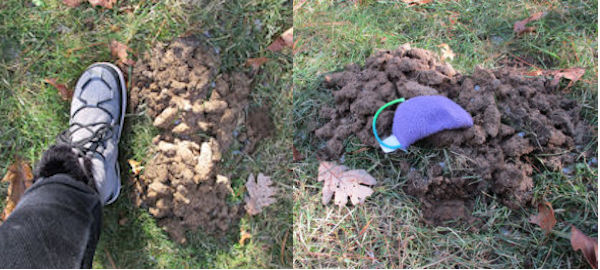
The image of the left is one of MANY (a dozen or more) huge molehills in my yard. The image on the right shows the same molehill with one of my cat’s toys (approx. the same size as a mole) on top, for perspective. That’s a LOT of dirt!
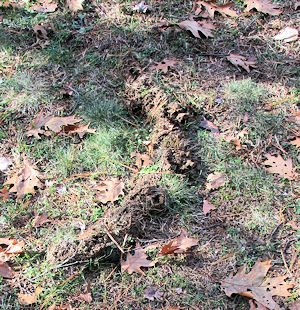
One of the “shallow tunnels” running all through my yard; when you walk on the lawn, it flexes under your feet.
I love wildlife of all kinds. I try to maintain a “live and let live” attitude. Bunnies can nibble in my gardens, deer can poop on my lawn, birds are welcome at my feeders and in my trees (I didn’t even get too excited when a mouse moved into the barbecue, although my husband wasn’t all that impressed). But this mole has GOT TO GO! Despite assertions that moles are “helpful” (by aerating lawns and eliminating grubs and earthworms), what they’ve done to my lawn is hideous (not to mention dangerous!) And while I don’t have the patience to catch and release them (not with that much lawn to watch on the off chance I’ll see one and manage to catch it), I also don’t want to trap and kill them (touted as the “most effective way of getting rid of moles”). I’m struggling to find alternatives: options include expensive sonic devices (I can’t even imagine how many I’d need to cover my whole yard and garden), mole repellent granules (which don’t appear to be available in Canada), installing barriers along garden or property edges (I have several hundred yards/meters of garden edge to protect, so – not practical), keeping the lawn/gardens dry (not good for the grass or plants), getting a dog that barks (not happening), and spraying the lawn with a castor oil and water concoction. Once again I only came across one or two sites that mentioned shoving mothballs down the holes; I do believe it worked in 2017, even though some of them got shoved right back out again!
So, I’m at a crossroads. There’s nothing I can do right now, but I will have to spend some time this winter on research, planning and preparation. Come spring, I will find my little ‘undercover’ friend, expose him (or her), and find a way of eliminating the threat. I’m not about to let a tiny little infiltrator get the better of me here on … the other side of 55.
Comments are closed.
Love it! 🙂
Thanks!
We have them here too and they literally destroy yards, not to mention those dirt tunnels of upheaval are dangerous to trip over. I don’t know what the best solution is but when we had our cat (she was both an indoor and outdoor kitty), she caught those critters and they stayed away from our yard.
My cat is strictly indoors, so that’s not an option, unfortunately. The mess the mole makes in the lawn is bad enough, but s/he’s also tunneling through gardens I’ve spent three years cultivating and I expect there will be some damage evident come spring. I’m going to try the moth balls again, and I may have to resort to some sort of deep edging around the labyrinth I plan to construct in the middle of the yard (it will take weeks of layout and digging, etc. – I don’t need him destroying it!) I love all of God’s creatures, I really do. I just wish they had a little more respect for my space!
I’m not a ‘live and let live’ person when it comes to mice and gophers and such. Give them an inch and they will take a mile, as they say. When we trap them we toss their little bodies into the woods and let nature recycle them!
There’s a mouse trap in the barbecue now (I just don’t look!) Trapping moles is a tricky business, because they don’t reuse the shallow tunnels, so you have to figure out which deep tunnels and “home” they’re frequenting and place the traps there (which basically means digging up half my yard). I’ll try the mothballs again (it always worked with skunks and it did deter the mole 2 years ago); the faint smell that wafts across the yard reminds me of my grandmother’s cedar chest!
We’ve had really good luck with a sonic system for getting rid of bats at the AZ house. (Seems to deter the doves, too…) I wonder if there is such a thing for moles!?
There is! I was actually chatting to a fellow in the hardware store today about them. He uses them to keep mice and rats out of his barn; he did say, however, that it also scares the birds away (maybe more than doves). I like my birds (doves included), so not sure its a solution for me.
Our bat deterrent keeps the bats from going under the roof tiles (at the eves) and keeps the doves off the columns where the deterrents are plugged in. But it doesn’t keep the doves off the peak of the same roof. I guess you would want to know what the range is!
Well, at least we don’t have moles, gophers aplenty, but no moles. I must say, your moles are pretty cute and I can understand your reluctance to trap them. I cringe when I bring up a gopher trap, praying the poor thing is dead and died an instant, painless death. Just in case, I keep my henchman (a border collie) nearby to quickly dispatch any survivors. Gophers do kill plants and they have killed one of my young apple trees and damaged countless other plants.
Moles don’t eat plants but they can destroy the root systems by tunneling through them. I’ve spent too much time and effort in my gardens to allow that to happen! And the mess in the lawn is insane – its like walking on a water bed (when its not frozen). I’ve let my husband trap mice in the house, but when something’s just “doing its thing” outside, I hate to kill it!
I have 80 acres that are littered with mole hills. They make for a rough ride on the tractor but in the end if they stay out of my vegetable garden and lawn I leave them alone.
I wouldn’t mind if they kept to the forested areas, or the front section out by the road. But they seem to prefer my lawn and garden (probably because I take such good care of it! LOL!)